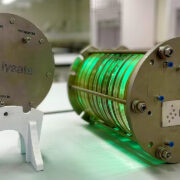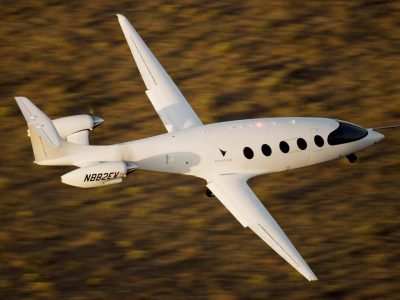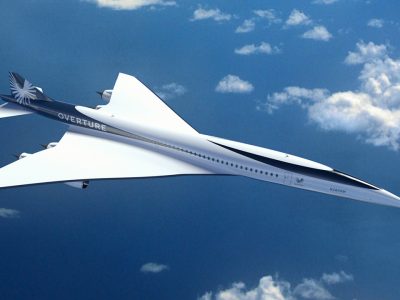Airships: the number one sign that you’re in an alternate universe, or a Miyazaki movie. While they may seem like a bad idea, because they’re not as fast as planes or as powerful as freighters, airships actually sit in a goldilocks zone in between them. There are some interesting benefits that innovators are trying to tap into by applying new technology to these old machines. Are these giants from a bygone era really ready to make a comeback and impact our lives? Are Zeppelins the first step in the Stairway to Heaven? Or is this just another billionaires pipe dream?
Last Time on Airships
We last talked about airships or Lighter-than-air (LTA) vehicles back in 2021. I’d say it’s time to check in and see if there’s been any progress or new innovations in the field. But first, are airships safe? Aren’t they floating hydrogen balloons waiting to explode? Short answer: No. Long answer: we’ve replaced the hydrogen with the much more stable helium. Plus, safety standards for all vehicles have improved. I mean, just look at how far cars have come in 100 years.12 Or better yet, planes! Longer answer: go check out my last video.
Then there’s this. Planes move people and goods around super fast but they make up 2.5% of global carbon emissions by themselves.
In comparison, airships are much greener. Why? Because planes have to go fast to stay in the air, which necessitates burning a lot of not-very-green fuel. In terms of sea transport, the mechanics of water travel mean that while freighters can carry an awful lot.3 4 But it does take a lot of oomph to move them, and that oomph comes from some of the dirtiest fuel in the world.5 Often, the ships are registered in the places with lowest environmental standards as well.
Airships may sit in a happy middle ground. They can carry a lot more than planes, and move a lot faster than freighters. And by surfing the prevailing winds, such as those that drive the Gulf Stream, , they can travel at a respectable speed without burning much fuel at all.6 In fact, a paper released in 2022 has already calculated the greenest paths for airship travel — routes where they catch the best wind currents while absorbing the most solar energy.7
New Advancements
If you caught our last airship video you probably remember this. I mean, how could you forget? That’s the Airlander 10, AKA the Flying Butt, developed by UK-based Hybrid Air Vehicles (or HAV). What’s up with the weird shape of this craft? It actually produces up to half of the vehicle’s lift aerodynamically, i.e like a plane. Its four engines and auxiliary wings help with that. These features allow the Airlander 10 to merge the best qualities of a zeppelin and a plane. It definitely puts the ‘hybrid’ in Hybrid Air Vehicles.8
Last time we talked about the Airlander, they showcased the luxury sightseeing version of their cabin, complete with a bar and lounge. Now, HAV has a modular gondola that they can configure to haul cargo, or up to 100 passengers.9 This version of the Airlander is set to undergo flight testing in 2026 and enter commercial service by 2029.10. Currently, the Airlander uses four diesel engines. This diminishes those green benefits we mentioned a moment ago. Butt HAV and their partners at Collins Aerospace and the University of Nottingham think the Airlander will be all-electric as early as 2030. An electric Airlander will produce 90% fewer carbon emissions than other craft, according to HAV.11 If all goes to plan, this will make the Airlander the first large, zero-carbon, regional aircraft on the market.12 The big news from HAV is that they’re developing an even bigger butt. The appropriately named Airlander 50 will carry a whopping 50 metric tons of freight or 200 passengers. A fully electric version of the Airlander 50 is on track to debut in 2033.13 Obviously, the date is really floating out there.
Now let’s talk about some new arrivals to the green airship scene. First up, Google-founder Sergey Brin and his California-based company, Lighter Than Air Research (LTA Research). LTA Research may be new to me, but they aren’t new to the airship game. It’s been working on airships since at least 2015.14 The team’s design was shrouded in secrecy until late last year, when the Pathfinder 1 began conducting some early test flights. These were mostly indoors or just a few feet above the ground, but the U.S. Federal Aviation Administration (FAA) has recently given the Pathfinder 1 the green light to fly near the Palo Alto, California airport, and over the southern part of the nearby San Francisco Bay.15 Though an impressive 400 feet (121.9 meters) in length, it’s only half the size of the Hindenburg. Maybe not the best thing to compare it to … too soon? Still, it’s longer than three Boeing 737s, making it one of the biggest aircraft in our modern skies.15 Size matters, especially when you consider the square-cube law.
What is that? Well, check this out. Planes get their lift aerodynamically, which requires a certain amount of speed. Airships get their lift aerostatically, or from the volume of gas in their balloons. The square-cube law states that as an object gets bigger, its volume increases faster than its area.16 For example, if you were to double the size of a cube, its surface area would quadruple, while its volume would octuple. So as airships get bigger, they quickly get better at lifting things. This makes the idea of creating jumbo-airships like the Pathfinder 1 very appealing, at least on paper.17
Back to the Pathfinder 1. LTA Research has mounted a LiDAR system inside each of the Pathfinder’s ballonets. Disappointingly, ballonets are smaller gas bags inside the airship’s rigid frame, not bayonets used to ward off sky pirates. Anyway, LiDAR or (laser imaging, detection, and ranging) works by firing out a laser pulse and then measuring the time for the reflected light to return to the receiver. Doing so allows the LiDAR to quickly and accurately map its surroundings. It has a ton of applications, from being the “eyes” of self-driving cars, to helping us map the bottom of the ocean and Mars, to solar and wind farm optimization. 18 LTA Research is using it to continuously monitor the ballonets for punctures or other issues and accurately calculates the volume of helium. This feedback should make the Pathfinder easier and safer to pilot.19 A combo of diesel generators and lithium-ion batteries powers the Pathfinder, though there’s a plan to make it totally electric, just like the Airlander. LTA Research CEO Alan Weston told Popular Mechanics in an August 2023 interview that they’re also considering adding solar cells or hydrogen fuel cells to their Airship.20 Can’t get much greener than that!
Some of the biggest advances made by LTA Research are in the manufacturing process. Historically, companies would put up a mass of scaffolding to build an airship layer by layer. This meant workers were performing delicate operations at great heights, and injuries were common. As you can imagine, this made building an airship expensive and dangerous.21 As for how they used to build them, Alan Weston said:
“In the old days, people were climbing up 100-foot ladders.” -Alan Weston22
With that in mind, LTA Research developed a “rotisserie-chicken-style” system that rotates their entire airship skeleton. This allows the air-shipwrights (which, by the way, is probably the coolest job title ever) to do their thing safely on the ground. The process involves using lasers to measure the position of every tube and joint on the airship. The lasers work in tandem with actuators to carefully shift the hulking airship just a couple of millimeters at a time.22 LTA Research is confident that by combining this tech with modern alloys they’ll be able to construct their airships more easily and cheaply. Considering the price tag airships have historically had, I hope they’re right.
Especially because of this. How are you going to get a massive amount of emergency vehicles into a place like this? Natural disasters don’t tend to spare the ports, roads, and runways. It’s a logistics nightmare, lives are on the line, and every second counts. Yet Airships like the Pathfinder 1 can just float over any and all rough terrain and land where they’re needed most.14 Nothing else really fills this humanitarian niche (at least at a large shipping scale), so this application is particularly cool.
Speaking of humanitarian applications, let’s talk about another fresh face on the scene, the French startup Flying Whales, and their LCA60T. Not exactly a catchy name — but when is French ever catchy to an Englishman? In any case, this company is designing a literal flying hospital called Flying Care. The idea is to use vertical landing features to bring doctors right to the heart of a problem. Now that’s a housecall!2324 While this idea is very neat, it wasn’t the reason why Flying Whales designed the LCA60T. This was.
You see, the French Forestry Service has a problem. It’s difficult to move people and cargo through their mountains and forests without disturbing them. Why not fly over them in an airship? 23 But say there’s no landing zone, even for a big balloon. Perhaps the cargo’s too big for the LCA60T’s 96-meter-long hold. (Nope, still not a catchy name.) In a scenario like that, though, the airship can deploy “transport underslings” to reel in smaller objects and airlift bigger ones.24
And this got the Flying Whales thinking… If the LCA60T can tackle big, unwieldy cargo like logs, it can probably handle other big, unwieldy things. I could have probably phrased that better … but I’m talking about energy towers and wind turbine parts.25 Physically transferring monolith-like construction pieces to their installation site is a huge undertaking. It requires years of careful planning and logistics. Currently, helicopters handle the most awkward parts of the journey. But, based on its benchmark tests, Flying Whales claims that its airship can haul three times the payload of modern helicopters, with 15 times less carbon emissions — all while being cheaper to produce.26
Are we actually any closer
This sounds very promising, so why aren’t the skies full of airships already? Well, there’s still some science and engineering riddles we’re going to have to solve before airships make the jump from steampunk to solarpunk.
Arguably the most pressing issue is the load-exchange problem. Airships have enough lift to haul heavy cargo, but what happens when you drop that cargo off? How do you stop the airship from shooting upward like a runaway party balloon? The easiest way is to adjust your lift by releasing enough gas to zero out the cargo you just dropped. This would be acceptable with hydrogen, but belching out expensive and rare helium just isn’t going to fly, financially speaking. Especially if you’re making multiple trips per day, as a commercial plane does.26
Therefore, the simplest way to handle the weight-exchange problem is by using ballast. Let’s say your airship wants to pick up 5 tons of lumber, so it sets off with 5 tons of water already onboard. As you pick up lumber, you release the water. Hot air balloons already do this with sand bags. Easy, right? Well, only theoretically. Dynamically accounting for every pound in real time is tricky. A miscalculation or sudden gust could lead to a very expensive and dangerous mistake.26
Here’s a very cool possible solution. Use a compressor to squash that helium closer together, and voila, the airship has less lift. This technique is actually already in use for underwater remotely operated vehicles (or ROVs). Understandably, it’s a lot trickier to pull off in the sky.27 And air compressors with these abilities are just too heavy for most airships right now. In a 2022 video, Bloomberg asked Flying Whales CEO Sebastien Bougon about compressor tech, and he said he thinks this technology will be viable sometime in the next 5 to 10 years.26 I hope he’s right. Nobody wants to add yet another name to the list of revolutionary tech that will forever be “5 to 10 years away.”
There’s also the problem of public perception. When most people hear the word “airship,” chances are the Hindenburg disaster is immediately at the forefront of their minds.1 Will airships, especially commercial passenger airships, be able to overcome this negative public image? Or will the ghost of the Hindenburg forever haunt the tech’s legacy? That’s an important question, and we won’t really have an answer until we actually have a few more airships flying around.
The use of helium should make most people feel safer but helium has its own issues. While helium is the second most abundant gas in the universe, it’s quite hard to come by on Earth. It’s mostly found deep under our crust which makes it hard to extract. And it’s primarily found in just four countries, making it vulnerable to supply chain or market hiccups. One of the chief producers of helium is Russia, and the ongoing war in Ukraine has seen Russia curtail its sales of the precious gas.28 Think about that the next time you want to do that squeaky voice gag! We could always switch back to hydrogen, we know a lot more about it and have better safety procedures now. Hydrogen is less dense than helium and a lot cheaper, making it less of a bummer to release for load-exchange reasons. But the United States has banned its use in military aircraft since 1922, following another, pre-hindenburg zeppelin disaster.29 That ban is still on the books. And even if the ban were lifted tomorrow, hydrogen balloons might still scare away potential passengers.
At the end of the day, though, the biggest hurdle facing airships remains the same ol’ for just about everything: their high cost.30 R&D is expensive. Establishing new manufacturing techniques and fabricating the airship is expensive. Airship pilots are rare; there’s only 17 certified, full-time airship pilots in the entire United States.30 Then there’s the fuel. Filling even a small airship (think Goodyear Blimp) with enough helium for just one trip is estimated to cost up to $100,000.30 And even if it all goes to plan, you still have to prove it’s safe to the FAA. Here too, the song remains the same. Certification is a long and expensive process.1424
Nose to tail, the whole thing is costly, and this is going to be reflected in the ticket prices. Back during their heyday, a transatlantic zeppelin trip was two days faster than a cruise and about 5.5 times more expensive. And they’re still pricey today.31 Granted, there’s no data yet on modern passenger or cargo ticket pricing, but there sure is for luxury skycruising. OceanSky Cruises, a Swedish airship service, claims it will be flying luxury tours of the North Pole aboard the Airlander 10 starting in 2026. The price? A mere $200,000 USD.32 For totally unrelated reasons, you can donate to my Patreon here. Jokes aside, the high prices may have done more to kill the zeppelins than the safety issues in the past. Would this be another case of history repeating itself?
That said, I promise it’s not all pies in the sky. Despite all these challenges, airships aren’t that far away, even if only in the history books. Remember, the FAA recently certified the Pathfinder 1. Sure, it’s just for test flights. But every airship certified helps set a safety standard for other airship companies to follow. It normalizes the process, opening the door for more vessels in the future. Meanwhile, HAV boasts that the first commercial Airlander 10 will roll off the assembly line in 2026.33 Some airlines, like Hibernian and Mel Air, have already pre-ordered their Airlanders.10 And the United States’ Department of Defense (DoD) awarded HAV a contract last December.34 They’re thinking about using the Airlander 10 in a maritime logistics support role. So it might not be too long before we see naval or coastguard LTA craft again. And though Flying Whales is still in what it calls the “de-risking phase,” its prototype should take flight in 2025.35 It seems like we’re going to be seeing these first deployed in market segments that can foot the hefty bill.
Will these not-so-antiquated airships be our future, or or has the ship sailed on airships? They really do look like they’ll fill their niches, but it’s highly doubtful that they’ll ever fully replace planes and freighters. There are still significant challenges for airships to overcome before that’s even a possibility. Will companies like HAV, LTA Research, and Flying Whales be able to handle these challenges in a way that makes financial sense? Will Airships ever get over their Hindenburg-related image problem? Or will it all go down like a lead balloon? That all remains to be seen. A sky filled with green airships might not be too far off — at least as long as they can keep the prices down.
- NBC – Zeppelins stopped flying after the Hindenburg disaster. Now scientists want to bring them back ↩︎
- Royal Aeronautical Society – Airships Seek New Role ↩︎
- Our World in Data – Emissions from Aviation ↩︎
- Our World in Data – Emissions by Sector ↩︎
- Yale Environment 360 – At Last, the Shipping Industry Begins Cleaning Up Its Dirty Fuels ↩︎
- ‘Using the jet stream for sustainable airship and balloon transportation of cargo and hydrogen,’ Julian David Hunt, Edward Byers, Abdul-Lateef Balogun, Walter Leal Filho, Angeli Viviani Colling, Andreas Nascimento, Yoshihide Wada, Energy Conversion and Management: X, Volume 3, 2019 ↩︎
- ‘Design and route optimisation for an airship with onboard solar energy harvesting,’ Christoph Pflaum, Tim Riffelmacher, and Agnes Jocherb, Pages 289-303 | Received 12 Dec 2022, Accepted 31 Jan 2023, Published online: 20 Mar 2023 ↩︎
- Wikipedia – Hybrid Air Vehicles Airlander 10 ↩︎
- HAV – Airlander 10 Mobility ↩︎
- Aerospace International – Hybrid Air Vehicles secures more orders for Airlander 10 ↩︎
- HAV – Our Craft, Airlander 10 ↩︎
- HAV – The Next Steps on the Airlander’s Journey towards Electrification ↩︎
- HAV – Our Craft, Airlander 50 ↩︎
- IEEE Spectrum – Google Founder’s Airship Gets FAA Clearance ↩︎
- TechCrunch – The world’s largest aircraft breaks cover in Silicon Valley ↩︎
- Wikipedia – Square-Cube LAw ↩︎
- Eli Dourado – Cargo airships could be big ↩︎
- Wikipedia – LiDAR ↩︎
- Flying Magazine – LTA Pathfinder Debuts ↩︎
- Popular Mechanics – The Electric Airship Revolution Is Almost Here. Are We Ready? ↩︎
- The Tillamook Air Museum ↩︎
- Bloomberg – Sergey Brin Has a Secret Plan to Put Airships Back in the Skies ↩︎
- Wikipedia – Flying Whales ↩︎
- Flying Whales – The LCA60T ↩︎
- Flying Whales – Energy ↩︎
- Bloomberg – How Airships Could Overcome a Century of Failure ↩︎
- IEEE Spectrum – No Propeller? No Problem. This Blimp Flies on Buoyancy Alone ↩︎
- Forbes – Why The Global Helium Shortage May Be The World’s Next Medical Crisis ↩︎
- Airships.net – Hydrogen and Helium in Rigid Airship Operations ↩︎
- Airways Magazine – What Happened to the Great Airships? ↩︎
- Outrun Change – 1937 Transatlantic Transportation costs ↩︎
- OceanSky Cruises – Contact & Common Questions ↩︎
- Airport Technology – Airlander 10 set to make airshow debut in 2027 ↩︎
- Insider Media – HAV signs contract with US DoDt ↩︎
- Airport Technology – Flying Whales eyes cargo revolution with a familiar solution ↩︎


















Comments